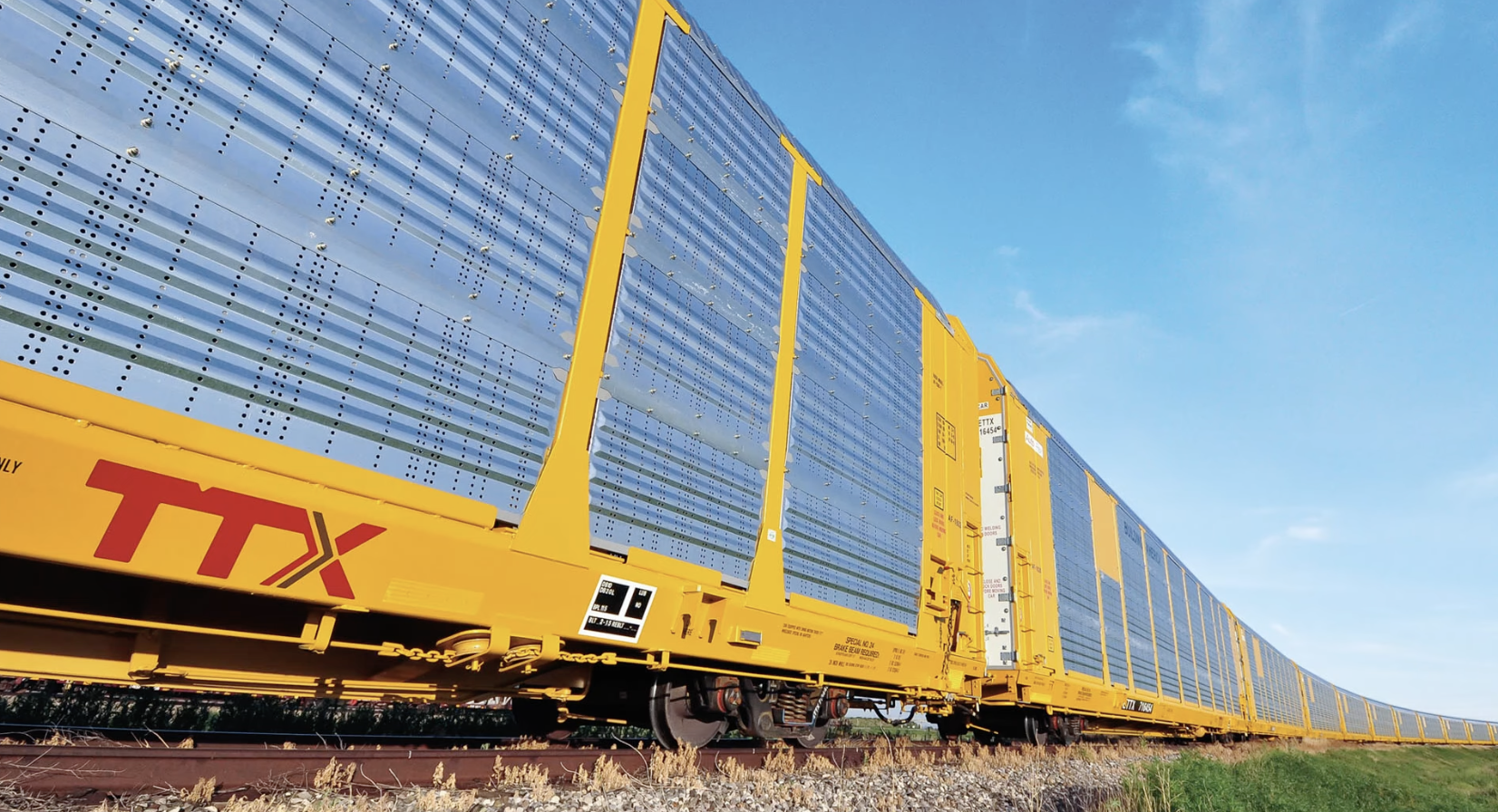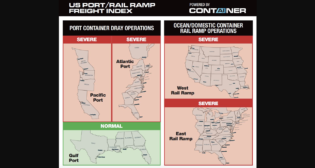
U.S. Carloads, Intermodal Down for June; Industrial Products Reflect ‘Relative Strength,’ AAR
Written by Marybeth Luczak, Executive Editor
(Screen Grab Courtesy of TTX YouTube Video)
U.S. rail traffic for June 2023 was down from the same month last year—falling 3.9%, or 76,237 carloads and intermodal units, the Association of American Railroads (AAR) reported July 5. This follows May’s 5.7% drop-off from the prior-year period.
According to the AAR, U.S. Class I railroads last month carried 1,892,163 carloads and intermodal units, comprising 903,397 carloads (down 0.2%, or 1,931 carloads, from June 2022) and 988,766 containers and trailers (down 7.0%, or 74,306 units, year-over-year).
“Recent rail traffic patterns point to contrasts in the broader economy,” AAR Senior Vice President John T. Gray noted in the association’s report on U.S. rail traffic for June 2023 and the week ending July 1, 2023. “For example, rail intermodal is largely consumer goods, but recent spending on goods has cooled considerably and, with it, intermodal volumes. On the other hand, rail carloads of industrial products are performing much better, reflecting relative strength in the auto, mineral extraction and other sectors.”
In June 2023, 11 of the 20 carload commodity categories tracked by the AAR each month saw carload gains compared with June 2022. These included motor vehicles and parts, up 11,142 carloads or 21.1%; metallic ores, up 4,786 carloads or 22.0%; and crushed stone, sand and gravel, up 4,540 carloads or 5.4%. Commodities that saw declines included grain, down 19,752 carloads or 24.0%; coal, down 3,772 carloads or 1.5%; and chemicals, down 3,750 carloads or 2.9%.
Excluding coal, carloads were up 1,841 carloads, or 0.3%, in June 2023 from the year-earlier period. Excluding coal and grain, carloads were up 21,593 carloads, or 3.8%.
In comparison, in June 2022 rail traffic was “a mix of red, yellow and green,” like other economic indicators, John T. Gray reported July 6, 2022, “with some traffic lines, such as automotive, providing generally positive indicators, while others, such as chemicals, being a bit more subdued than they were earlier in the year.” U.S. Class I railroads hauled 1,157,555 carloads in June 2022, down 1.5%, or 17,970 carloads, from June 2021; and 1,323,119 containers and trailers, down 4.6%, or 63,483 units. Combined U.S. carload and intermodal originations in June 2022 came in at 2,480,674, down 3.2%, or 81,453 carloads and intermodal units from the same month in 2021.

What was happening in June 2021, June 2020 and June 2019? Let’s review:
- U.S. rail volumes in second-quarter 2021 “reflect an economy that is in much better shape than it was but still has room to grow,” Gray reported July 7, 2021. In the second-quarter, total U.S. carloads were the highest since fourth-quarter 2019; carloads excluding coal were the highest since third-quarter 2019; and intermodal and chemical volumes were “both the highest for any quarter in history,” Gray noted. Additionally, carloads of steel-related commodities were “relatively strong in the second quarter, reflecting higher demand as the industrial economy continues to recover,” he said. In June 2021, U.S. railroads originated 1,175,232 carloads, rising 19.1%, or 188,164 carloads, from June 2020, while they originated 1,386,745 containers and trailers, increasing 10.9%, or 136,634 units. Combined, June 2021’s originations came in at 2,561,977, up 14.5%, or 324,798 carloads and intermodal units from June 2020.
- “June [2020] was a month in which the slow recovery process that began in early May [following the start of the pandemic], began to accelerate,” reported Gray in a July 1, 2020 AAR traffic report. “By the end of June [2020], freight loadings had improved by about 60,000 carload and intermodal units weekly over where they had been in late April.” U.S. railroads originated 794,256 carloads in June 2020, down 22.4%, or 228,975 carloads, from June 2019. U.S. railroads also originated 1,004,933 containers and trailers in June 2020, down 6.6%, or 70,994 units, from the same month last year. Combined U.S. carload and intermodal originations in June 2020 were 1,799,189, down 14.3%, or 299,969 carloads and intermodal units from June 2019.
- “June [2019] marked the fifth straight monthly decline for total U.S. rail carloads and for U.S. intermodal traffic,” Gray reported July 3, 2019. “Manufacturing is responsible for much of the rail traffic base, but U.S. manufacturing output has been falling for several months. Housing, too, is in the doldrums, and trade is suffering because of tensions with trading partners overseas. Taken together, demand for rail service just isn’t as strong as it was six months or a year ago. Obviously, railroads hope things turn around, both for their own sake and for the sake of the broader economy.” U.S. railroads originated 1,023,394 carloads in June 2019, down 5.3%, or 57,173 carloads, from June 2018. U.S. railroads also originated 1,075,974 containers and trailers in June 2019, down 7.2%, or 84,002 units, from the same month in 2018. Combined U.S. carload and intermodal originations in June 2019 were 2,099,368, down 6.3%, or 141,175 carloads and intermodal units, from June 2018.

Year-to-Date 2023
Total U.S. carload traffic for the first six months of 2023 was 5,843,735 carloads, up 0.6%, or 32,547 carloads, from the same period last year; and 6,113,595 intermodal units, down 10.3%, or 698,375 containers and trailers, from last year, according to the AAR.
Total combined U.S. traffic for the first 26 weeks of 2023 was 11,957,330 carloads and intermodal units, a decrease of 5.3% compared with last year.
Week Ending July 1, 2023
Total U.S. weekly rail traffic was 474,443 carloads and intermodal units for the week ending July 1, 2023, down 3.2% from the same week in 2022, according to the AAR.
Total carloads came in at 223,254, down 1.7% from the same point last year, while U.S. weekly intermodal volume was 251,189 containers and trailers, down 4.5% from 2022.

Four of the 10 carload commodity groups posted an increase for the week ending July 1, 2023, compared with the same week in 2022. They included motor vehicles and parts, up 2,509 carloads, to 15,507; nonmetallic minerals, up 2,183 carloads, to 34,409; and metallic ores and metals, up 2,074 carloads, to 22,880. Commodity groups that posted decreases included grain, down 5,472 carloads, to 15,716; coal, down 4,430 carloads, to 59,949; and forest products, down 922 carloads, to 8,321.

North American rail volume for the week ending July 1, 2023, on 10 reporting U.S., Canadian and Mexican railroads totaled 326,715 carloads, dipping 1.1% from the prior-year period, and 330,637 intermodal units, decreasing 5.7% from last year. Total combined weekly rail traffic in North America was 657,352 carloads and intermodal units, down 3.5%. North American rail volume for the first 26 weeks of this year came in at 16,816,097 carloads and intermodal units, a fall-off of 4.0% from 2022.

Canadian railroads reported 86,614 carloads for the week ending July 1, 2023, down 3.2%, and 67,511 intermodal units, down 12.8% from the same point last year. For the first 26 weeks of 2023, they reported cumulative rail traffic volume of 4,149,703 carloads, containers and trailers, a 1.4% decline from the same period in 2022.

Mexican railroads reported 16,847 carloads for the week ending July 1, 2023, rising 21.9% from the same week last year, and 11,937 intermodal units, gaining 18.2%. Their cumulative volume for the first 26 weeks of this year was 709,064 carloads and intermodal containers and trailers, up 2.9% from the year-ago period.



